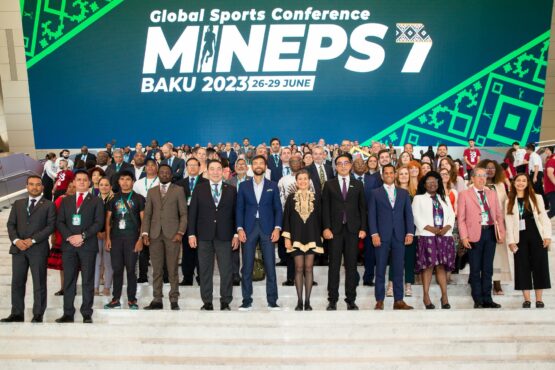
Peace and Sport’s approach aligned with MINEPSVII’s recommendations
Peace and Sport supports UNESCO’s and its Member States’ recommendations conveyed at the 7th International Conference of Ministers and Senior Officials Responsible for Physical Education and Sport (MINEPS VII) in Baku.
From 26 to 29 June, MINEPS VII gathered governments and civil society organizations to acknowledge the Fit for Life global initiative as the implementation framework of the 2017 Kazan Action Plan, with two main goals: to enhance Member States’ capacities for inclusive sport’s policies and to scale public and private investments in sport.
The bottom-up, participatory, and inclusive approach advocated for the deployment of the Fit for Life initiative at the national and international levels fully aligns with Peace and Sport’s approach (Peace and Sport – Plaidoyer Novembre 2022 (peace-sport.org), focusing on three main areas:
1.An integrated approach to change minds, systems, and behaviors
The Fit for Life governance builds on the same inter-sectoral and collective work Peace and Sport has been developing within the Peacemakers Project. The MINEPS VII outcome document recommends associating the grassroots stakeholders with the design, implementation, and evaluation of programs (Paragraph n°9). Educators, field programs leaders, and community leaders are identified as Key partners for the international implementation plan (I.3 Annex 1) and Impact partners for the national one (II.4 Annex 2).
Peace and Sport’s recommendations:
-Fostering a bottom-up approach by including program leaders and educators.
The knowledge and experience of grassroots actors must be valued and integrated into the program’s construction to ensure relevance with local needs and ownership by communities.
-Associating and mentoring athletes
The Fit for Life initiative identifies athletes as Scaling Partners. Based on the experience of the Champions for Peace club, Peace and Sport highlights the need to mentor athletes from an early age and offer them frameworks for action to strengthen their impact as peacemakers.
→As an example of the necessary dialogue between decision-makers and grassroots stakeholders, Aminata Traore Sy, Founder of APJS in Mali and part of Peace and Sport’s Peacemakers Project, took the floor during the Multi-Stakeholder Forum in Baku. Aminata shared challenges women face in Mali, raising awareness among MINEPS VII decision-makers about the importance of consulting local actors.
2.Developing youth empowerment and capacity-building resources
A significant challenge identified as a critical factor of success by the MINEPS VII participants is youth empowerment and capacity-building to support the delivery of effective and inclusive sport-based programs in schools and communities. (Paragraphs n°11, 12, and 38). Local actors and young adults need targeted capacity-building tools to implement impactful programs and develop soft and hard skills. (II.1 and II.4 Annex 1)
Peace and Sport’s recommendation:
-Enhancing local capacity
The recognition of peace educators as a qualified and employable workforce is decisive. The professionalization of their status implies putting in place appropriate remuneration, providing dedicated training and orientation tools to accompany these men and women on whom the impact of the programs relies.
→ Peace and Sport developed its unique Methodology focused on building peace culture through 3 pedagogical cycles, providing a global project management framework and data collection through the devoted mobile application Peace and Sport x MyCoach. Trained as peace educators, young adults can reach their full potential and develop skills fostering employability.
3.Strengthening evidence to enhance impact
To foster public and private investment, MINEPS VII participants acknowledged the need to develop monitoring and evaluation tools (Paragraph n°17). The causal relationships between sport and peacebuilding, conflict, and violence prevention remains indeed to be demonstrated. Fit for life recommends updating tools and technics to evaluate the programs (II.1 Annex 1)
Peace and Sport’s recommendation:
-Promoting monitoring and evaluation at the community level
The evaluation methods currently available are essentially dedicated to the national level. Peace and Sport stresses the need to for a new paradigm by focusing on the community level, on a long-term vision, and on the impact criteria, adding the qualitative to the quantitative.
→ Responding to this international priority, in 2022, Peace and Sport launched a three-year collaboration with the University of Paris-Nanterre (UPN) to implement a project-level impact assessment study. This micro-social approach places itself between the international prescriptions and the realities on the ground to reflect all the experiences, opinions, and points of view of the stakeholder’s program. The initial results of the intermediary report highlight sport’s contribution to gender equality and living together, as well as the empowerment of the teachers and educators who develop new skills and knowledge. The growing need for institutional recognition and support for field programs also emerged from the study. (Mettre en illustration la couv M&E). This study falls within the framework of activities of the UNESCO-SPORTSD&P Chair.
Have a look at the initial results of the Peace and Sport/UPN study:
As a member of Fit for Life working groups and a permanent member of the UNESCO Intergovernmental Committee for Physical Education and Sport (CIGEPS), Peace and Sport will support the monitoring of the implementation of Fit for Life to unleash the power of sport and build a lasting culture of peaceful societies.
